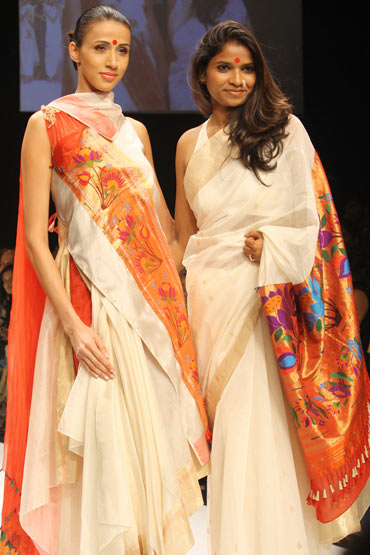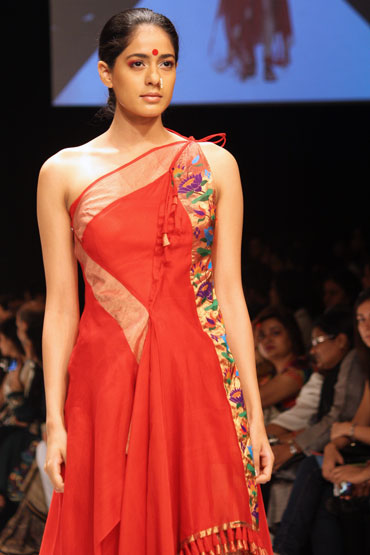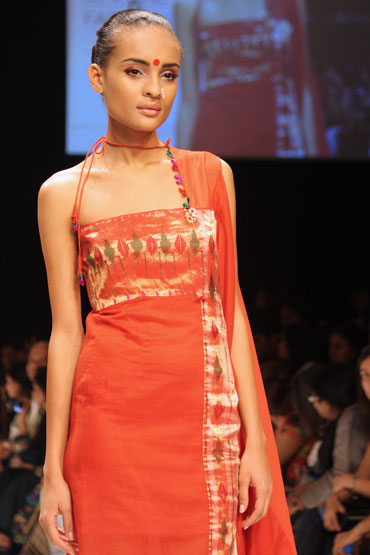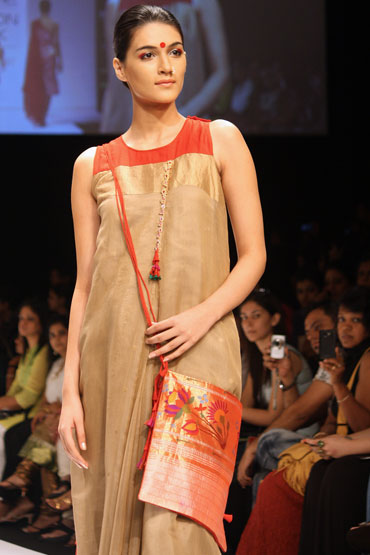
Fashion Week is also about young designers who are slowly making a mark. For example, it took Vaishali Shadangale more than a decade to find her calling as a celebrity designer and she still hasn't come to terms with the celeb status.
Just when we were talking about her small town journey from Vidisha district in Madhya Pradesh, a young gentleman came to her stall and exchanged greetings.
He introduced himself as an artiste and said how much he loved her collection from last season. "Ma'm, I was really inspired by your collection and I have made a painting for you," he said. "I don't know if you will like it, so, I will first mail you a copy. Please let me know if you like it or not."
Vaishali responded back, "Of course, I will like it. You can send it to me."
"Thank you so much m'am," he said and left.
"Wow, that was an interesting fan you earned. Are you ready to handle such attention?" I asked. "Not really. This is something new to me. I have just learnt to address the media. But I am an artiste myself and I could somehow relate to his excitement, so I would appreciate his efforts at gifting me a painting."
Needless to say, we wanted to know more about her journey so far and the designer's learnings from the industry.
So, Vaishali, could you tell us about your collection and your inspiration.
My last collection was inspired from my childhood memories. This time, I had some more mature learnings.
I realized that within me, there was a different me hidden within. One is real and the other is artificial. Like, when I am making a collection, it is me, my ideas, my expression and my imagination of art, the way it makes me happy. Similarly, when I meet clients, buyers or people in the industry, I act like a different person.
Similarly, each one of us have two different versions about us-the inner self and the outer self. My collection this season is something like that.
For example, last time my collection dealt with chanderi. This time I was intrigued by paithani. These are two entirely different forms of traditional art. I have tried to fuse the two and bring an altogether new dimension to the collection.

Any particular reason for choosing paithani?
It's been a long process of discovering the art and finding a way to execute it in my designs.
I visited this place called Yevala in Aurangabad where I realized that weaving the paithani was a means of living for people living there. And although the finished product, which is the paithani sarees is quite popular in Maharashtra, it was limited to the state alone.
I realized two things -- One, the manufacturing expense of paithani is quite high which makes it expensive and limited edition. Two, because it is expensive, the production is also limited.
I wanted people to realize the value of paithani and create something that was not only affordable but also easy to wear.
Like a paithani saree would make it difficult to sell across all demographics. But if I could create something that looked like a saree yet wasn't a saree and could be easily worn by anyone, that would be interesting I thought, and hence this collection.
I wanted to create something that was global, yet traditional and easy to wear.
Did you face any issues while working with the workers in Maharashtra? How did you convince them?
It was initially difficult to make them understand what I wanted from them. They were used to making saris and my concepts were new to them. But eventually they understood and worked according to my instructions.
It took me about six to eight months to finish the entire collection. It was a great learning experience for both of us.

How much time does it take to create an outfit like this?
The motif alone, the paithani work will take you about 25 days. The entire outfit would take an extra 20 days. So if you place an order, you will receive it in 40-45 days
What is the average price range of your collection?
It starts from Rs 3,000 and ranges upto Rs 25,000.
What kinds of buyers approach you? What is your perception about Indian buyers?
The one big problem with Indian consumers is that they come with a preset mentality. They see something that they like and they come to you expecting you to deliver them to you.
For example, anarkalis are in fashion this year. Everyone wants to wear an anarkali dress.
My only request to such buyers is when you come to me, do not come with a preconceived idea because my collection is different from what you have experienced outside.
We are still not open to experimentation. There are very few who willingly try out new things.
Even designers want to play safe with their creations. So, if they see that something is trendy, they try to personalize it, which is a very comfortable setting, but is not agreeable to me.

Given a choice, what is the one thing that you would like to change about the Fashion Week?
I think I am not very comfortable about the idea of having a showstopper for a designer.
In Payal Goenka's collection, Raageshwari was the showstopper. After the show, everyone from the media was busy interviewing Raageshwari and the designer was completely at loss.
I believe that a fashion show is about designers, their creativity, their collection and not showstoppers. Similarly, it is shameful how media ignores the models and their contribution towards the show.
I think it is the models and designers who need to be talked about rather than the showstopper.
A showstopper is good for publicity. Tomorrow, if time demands, even I may have one. But no designer would like it if they are sidelined for their work and something else takes centre stage.

One tip for aspirants and budding designers
I think it is important to finish a formal education in design and fashion so that you understand the technicalities better.
Similarly, education alone is not enough for success. You need to understand the industry and have the passion to give it your best each time.
If education is 40 percent, experimentation and experience forms the rest 60 percent of your knowledge.
Remember that as a designer you have the opportunity to set trends so make the best use of it. Do not get carried away by what others tell you or what is doing well commercially.
One fashion tip you would like to share with GenY.
Don't be influenced by what is trending outside. When you look for designer wear, go for stuff that is customizable to your body type. Learn to be comfortable with what you wear. Wear something that will suit your body type.
What have you learnt as an established designer?
I have learnt that creativity alone does not sell. You need to be able to market your designs. I have learnt how to talk to the press, buyers and customers.